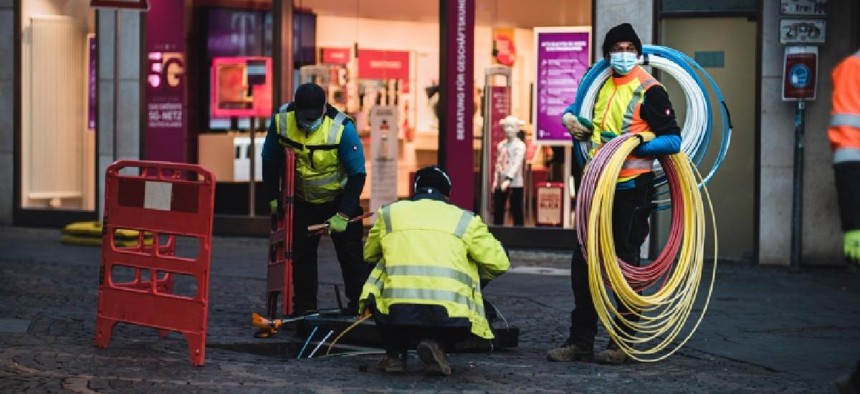Opinion
To improve health care disparities, close the digital divide

Technicians installing broadband pipes Mika Baumeister
The COVID pandemic has been a double whammy for the most vulnerable and disconnected. Those without the broadband internet at home struggled with distance education, telehealth, telework, and staying connected with family and friends. Now, many are unable to sign up online for the vaccines.
Roughly 30% to 35% of Black and Hispanic households aren’t connected to broadband, compared to 20% of whites; vaccination rates in these communities also lag. Currently, only 32% of Black and 35% of Hispanic Philadelphians are vaccinated, compared with 50% of whites.
Closing the digital divide will help us solve a lot of problems. Public health is one of the most important.
In Philadelphia, like most other cities, world-class broadband networks reach 99% of doorsteps, and 95% have a choice of providers. Yet, only 70% are actually connected at home.
We need a massive push to educate on the importance of broadband adoption and to teach digital literacy skills. If the federal government plays it smart, the infrastructure bill can make a major dent with a surgically targeted subsidy plan we know will work.
In Washington, both parties seem to be nearing bipartisan consensus on a massive $65 billion broadband plan. But most of that will be directed to rural areas that don’t yet have broadband pipes. This historic opportunity needs to also address the urban divide.
The urban adoption divide is wholly different from the rural access divide. Both are solvable. For years, Comcast and other broadband providers have offered $10-a-month plans to low-income groups.
It’s been the most successful digital divide initiative ever, moving 14 million Americans online. Efforts by progressive mayors in Philadelphia and Atlanta to cover the broadband subscription costs for school children during COVID also moved huge numbers online for remote education.
These efforts may sound like small-ball compared to a trillion dollar-plus infrastructure bill. But these smart, targeted adoption initiatives offer huge bang for the buck. And coupled with digital literacy training, these programs work.
This is where the feds can step in to help scale up solutions. Last December, Congress passed a temporary Emergency Broadband Benefit giving a $50 per month broadband stipend to low-income families. More than 1 million households signed up in the program’s first week.
Civil rights leaders are calling on Congress and the Biden administration to make this subsidy program permanent. A Permanent Broadband Benefit (PBB), modeled on the SNAP program for groceries and the Lifeline program for home phone service, would cost somewhere between $8-12 billion per year.
Surprisingly, the Biden administration has been slow to get on board. Instead, it’s flirting with a more convoluted approach pushed by tech-left activists: Doling out massive taxpayer funding to local governments to build and operate their own broadband networks – even in cities that already have ultra-fast networks.
But municipal broadband networks have a rich history of failure.
They are expensive to build: One recent study projected it would cost as much as $300 billion to build duplicative government networks nationwide. And they have a bad win-loss record of red ink. Here in Philly, the infamous wireless Philadelphia municipal WiFi debacle never even managed to get off the ground, much less live up to the hype.
Further, recent research suggests that just building additional networks does little to increase broadband adoption.
So why spend $300 billion on a strategy that has often failed when we can instead spend $8 billion on an approach we’ve already seen work?
Part of the answer is that there is a special interest constituency behind the building of these dubious municipal networks. Part of it is because in the age of social media, some local elected officials want a grand project to help build their “brand.” Either way, it’s a circuitous and fraught route in place of a highly effective one.
The infrastructure bill is a once-in-a-lifetime chance to fix a lot of things, including the digital divide. But Congress and the White House need to stay focused on ideas that will work, and stiff-arm the special interests and idealogues intent on stealing defeat from the jaws of victory.
We can solve the vaccination gap and both the rural and digital divides if we just stay focused on what works.
Dr. Sanul Corrielus is the president and CEO of Philadelphia Premier Cardiovascular Consultants LLC and the founder of Community Cardiovascular Initiative, a non-profit organization that focuses on providing integrated cardiovascular health and wellness education to underserved communities.
